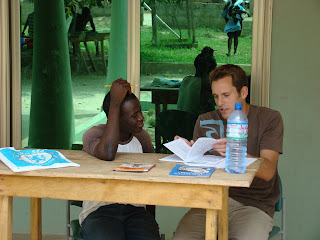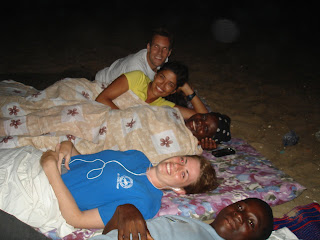Our conversations with Ben in Busua had spawned some curiosity about Okomfos. He'd visited six and said each was fascinating. We decided it was time to seek one out for ourselves. Last weekend we made this part of our mission as we traveled to the nearby town where Seth's children attend school.
Along the way, we stopped in a diamond mining village. There is a large mining company in the village, as well as many small-scale miners. These people employ labourers to dig in the riverbanks and hills of their land in search of stones. Once one stone is found, they scoure the area and usually find many more. Traders from Accra come once a week to buy the stones and take them to the city. From there they are sold off to exporters and sent to India to be cut and polished.
Though the diamond market was closed, it didn't take us long to find some men who were willing to show us some rough stones.


They wanted $120 USD for one of the small white stones. We also saw a much larger (5 carat) pollished stone for which the seller asked $6000 USD. There would be lots of room for bargaining on these prices, but we didn't want to get into that.
When we arrived in Seth's village, he connected us with some local friends of his for the visit to an Okomfo. We explained that we didn't want to curse anybody, but rather just wanted to learn about the powers and practices of the Okomfo.
We went to a shrine and found several of the shrine elders sitting outside, chatting in the shade. Seth and the two men explained why we had come and the men invited us in. While the rest of the elders gathered, we waited awkwardly, whispering to one another and looking at the various animal skulls and other artifacts in the room. We were told that the Okomfo was on her way, and in respect for Ghanaian tradition, we were asked to go around the room and shake each elder's hand, and then for one of us to stand and explain our mission. This done, they replied that the entry fee was either two bottles of whiskey or its equivalent in cash. Once this was paid, they said that our discussions could continue.
We knew a charge would apply for the visit, and our hosts didn't show any concern over this arrangement, so we agreed to pay. Once the money was safely tucked away in an elder's pocket, we were cordially informed that the Okomfo had performed rituals that morning and was resting, but that we would be welcome to return the next day.
Recognizing that we'd been scammed, I thought it best to decline their invitations for a return visit or for photos and to leave the shrine as quickly as possible. We then used Seth as a means to express our displeasure, seeing as he could speak their language and interpret the culture. The end result was a lot of arguing back and forth between the Ghanaian men and the return of some of our money.
Seth and his friends were far more cautious in agreeing to terms with the other Okomfo in town, who happened to be awake. We said that we were still curious but weren't willing to put up any more cash. We still had a bottle of whiskey that hadn't met the standards of the slimebags at the first shrine, though, so we did have that to contribute. We visited the second Okomfo and sat with him for a couple of hours, learning about his beliefs and powers and personal history.

It was all very fascinating. This particular Okomfo dealt in dwarf-spirits. Though we didn't pay the money he requested in order to play his drums to call out the dwarves. We did get a tour around his complex, though, and went inside the dwarves' hut, pictured below.

When I asked him his opinion of the other Okomfo in town, he casually informed us that she had passed away a year and a half ago.
I'll leave you with a photo of a blue bird:

- Davis






















































